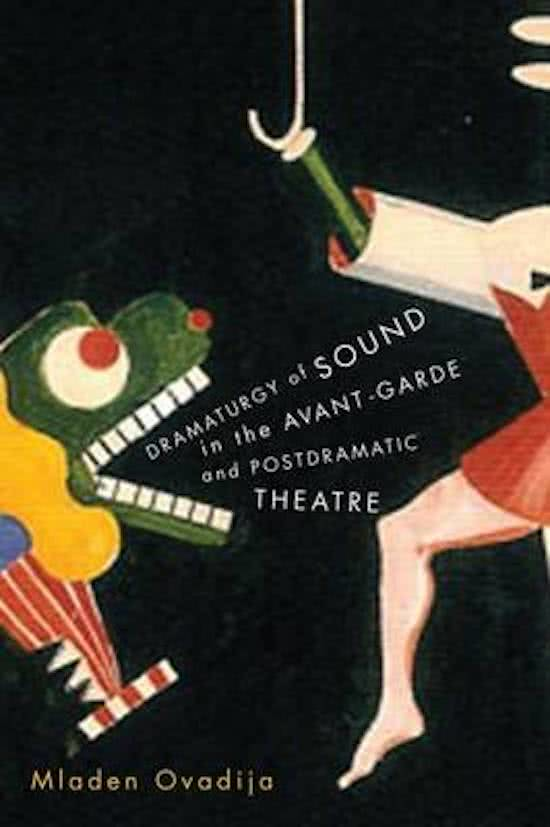Dramaturgy of Sound in the Avant-Garde and Postdramatic Theatre - Mladen Ovadija. Montreal: McGill’s University Press, 2013
by Jan Nieuwenhuis
Overall, Mladen Ovadija’s Dramaturgy of Sound in the Avant-Garde and Postdramatic Theatre is an interesting read for everyone interested in the avant-garde, postdramatic theatre and sound as art in general. He traverses through early twentieth-century history to trace sound in Russian and Italian Futurism, Bauhaus, Expressionism, and Dadaism. In contrast to the psychological, text-based theatre of the nineteenth century, these movements were more concerned with how a text might sound rather than the content, in terms of meaning, of the text itself, as demonstrated in Kurt Schwitters’ Sonate in Urlauten or the Russian Futurist experiments with zaum or “beyonsense.” Put differently, language’s sounds freed from a logocentric vision on text and instead appreciated as an autonomous material in itself. Moreover, Ovadija sees “the anti-textual sonority made by the historical avant-garde” as a primer for theatrical development in the course of the twentieth century and makes “a case for the centrality of sound as both a performative and an architectural constituent of contemporary theatre” (p. 5), to be heard in the performances of, for example, Robert Wilson and Theatergroep Hollandia. This results in a reading of the recent history of theatre and performance practices deriving from an aural perspective. Sound in the arts had already been studied elaborately, for example in Douglas Kahn’s seminal book Noise, Water, Meat: A History of Sound in the Arts, but had not yet been examined within theatre as such. This fact alone makes this book an interesting addition to the existing literature on sound, theatre, and the avant-garde.
Ovadija broadens theatrical discourse, not only by discussing the theatrical ideas of Wassily Kandinsky or Antonin Artaud but also by interpreting sound poetry as a performative act in itself. He boldly links the work of, for example, Hugo Ball, Kurt Schwitters, Filippo Marinetti, Velimir Khlebnikov, and Alexei Kruchenykh to the history of theatre. This opens up the opportunity for him to discuss works that are normally regarded as being outside theatrical discourse, but which, as he shows, had a profound influence on subsequent developments. “[S]ound,” as he states in his introduction, “reveals – or perhaps more appropriately, is – performance” (p. 3). This stance thus gives him the contextual space to address and incorporate a much broader spectrum of sound practices.
The book is quite accessible, which makes it a good read outside the academic circles, thus making a fascinating element of the historical avant-garde accessible to a much larger audience. While this is certainly a positive aspect for the dissemination of interesting material like this, Ovadija’s book lacks a thorough theoretical apparatus. He scratches the surface of the various theories connected with the avant-garde movements within a historical survey but does not dig deeper into their philosophical implications. And yet, the Futurists and the Dadaists, as well as the rest of the avant-garde for that matter, were specifically dedicated to transforming existing artistic practices, especially the ones pertaining to language and sound. Ovadija posits the theories in their historical context, yet abstains from a deeper investigation such as the one Helen Palmer, for example, undertakes in her book Deleuze & Futurism: A Manifesto for Nonsense (2104), where she connects zaum with the philosophy of Gilles Deleuze.
This being said, the connections Ovadija makes between the sounds of the avant-garde and postdramatic theatre are compelling and revealing. And despite the critique regarding theory above, it is my opinion that Ovadija’s hope, which he utters at the end of the book – that “the rediscovery of the pronounced orality/aurality of the postdramatic theatre […] may initiate the inclusion of the aesthetics and phenomenology of sound in contemporary theatre study” (p. 208) – has certainly been fulfilled with his own first step. Dramaturgy of Sound in the Avant-Garde and Postdramatic Theatre is a recommended read for anyone interested in the clamor of the avant-garde.

